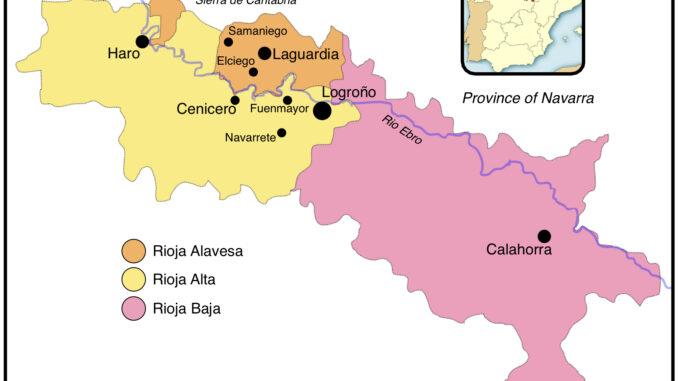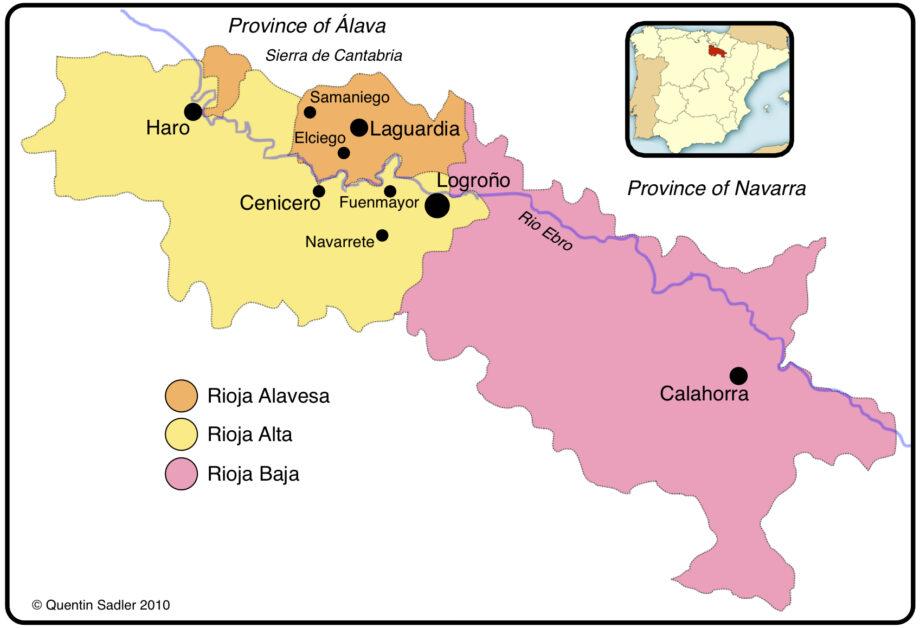
Let’s start with this easy questions and give an obvious easy answer. Rioja is definitely not a variety of wine grape. But, it is a word that is very much associated with Spanish wine. From this, we know that it is one of most well-known wine regions in Spain and around the world, both for its wines and for winemaking styles.
Rioja (La Rioja) is the wine growing region in northwestern Spain bounded by the Basque Atlantic coast on the west, the Pyrenees mountains on the north. This region has been harvesting grapes for winemaking since ancient times over ten centuries ago. It dates back to when the Phoenicians were carrying their culture (including agriculture and viticulture)and trade across the Mediterranean Sea on boats to western shores from Greece and the middle east. Like in many parts of Europe, winemaking traditions in Rioja were later influenced by monks and eventually evolved commercially.

Notably, Rioja was the first Spanish wine region to obtain DO (Designation of Origin) status, in 1925. In 1991, and was promoted to DOCa (Qualified Designation of Origin), a higher category reserved for wines showing consistent and proven quality over a long period of time. In Rioja DOCa, least 95% of the grapes in red wines must be from Tempranillo, Garnacha tinta, Graciano, Mazuelo (Carignan) and Maturana tinta with Tempranilllo in the lead role. Rioja has three distinct subregions with stylistic diversity:

Photo credit – Quintin Sandler’s Wine Page
Rioja Alta, located on the western edge of the region and at the highest elevations (up to about 2300 ft), is where growing conditions tend to be cooler with a shorter growing season that produces bright red fruit flavors and lighter style of wine.
Rioja Alavesa, somewhat lower (up to 1600 ft) at extends into the Basque country with an Atlantic influence, While having generally similar conditions as Rioja Alta, but at lower elevations and longer growing season, produces wines with fuller body.
Rioja Oriental (previously Rioja Baja), the lower regions (~900 ft) unlike the more continental climate of the Alta and Alavesa, the Rioja Oriental is generally lower in elevation and strongly influenced by a Mediterranean climate that makes this area the warmest and driest of the Rioja. These conditions lead to deeply colored wines with darker fruit characteristics, higher alcohol and lower acidity than wines from other parts of the Rioja.

Photo credit – Texas Fine Wine
Texans are very interested in red wines made with Tempranillo as it ranks in the top red grapes grown in this state. Texas Fine Wine has been active doing side-by-side blind tastings that included Texas and Spanish Tempranillos in what they call ”Texas Two-Sips”.

An example is a recent Texas ”Two-Sip” blind tasting that matched:
Texas Spicewood Vineyards 2019 Tempranillo, Texas High Plains (100% Tempranillo – aged just shy of a year in 15% each new French and American oak and 70% neutral oak with approximately 1 year in bottle) with grapes sourced from vineyards in the Texas High Plains at around 3200 ft in the Texas panhandle area, and
Spanish Roda 2017 Riserva (89% Tempranillo, 6% Graciano & 5% Garnacha – aged 14 months in French oak barrique (40% new) and 2-1/2 years in bottle. Tempranillo vineyards are located in Haro – bush vines of over 30 years on limestone soils. The Graciano is from further southeast the border between Alta and Baja with more alluvial soils.
Spicewood Vineyards 2019 Tempranillo brings black cherry up front and toasted oak with added aromas of figs and Mediterranean herbs with big flavors of black cherry and cocoa powder with lean and pleasant tannins on the finish. By comparison, the Roda 2017 Riserva focuses on red cherry, with tobacco on the mid-palate melded with blackberry, oak, smokiness with a hint of cedar.
All-in-all, it was a good showing all around. Each wine with distinct character define by its own terroir and culture, but with underlying similarities, no doubt.
Later this month, I hope to have a palate ”recalibration” for Tempranillo as the DOCa Rioja is coming to Houston for a trade tasting. I’m excited about revisiting the diversity of Spanish Tempranillo blends (and seldom tasted here) indigenous grape varieties, along with experiencing the Rioja microclimates, soil types, winemaking philosophies, and vintages old and new.




Be the first to comment